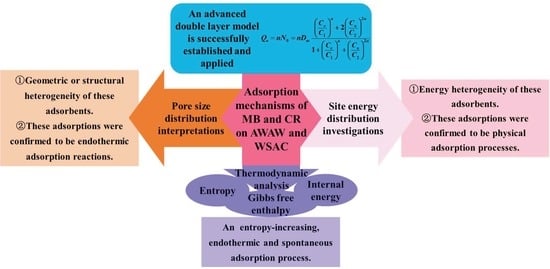Adsorption of Congo Red and Methylene Blue onto Nanopore-Structured Ashitaba Waste and Walnut Shell-Based Activated Carbons: Statistical Thermodynamic Investigations, Pore Size and Site Energy Distribution Studies
Abstract
1. Introduction
2. Materials and Methods
2.1. Batch Adsorption Experiments and Fitting Experimental Data
2.2. Theoretical Formalism: Double-Layer Model with Two Energies
2.3. Statistical Thermodynamic Functions
2.3.1. Entropy
2.3.2. Gibbs Free Energy
2.3.3. Internal Energy
2.4. Pore Size Distribution (PSD)
2.5. Site Energy Distribution (SED)
3. Results and Discussions
3.1. Statistical Thermodynamic Investigations
3.1.1. Entropy
3.1.2. Gibbs Free Energy
3.1.3. Internal Energy
3.2. Pore Size Distribution (PSD) Explorations
3.3. Site Energy Distribution (SED) Studies
4. Conclusions
Supplementary Materials
Author Contributions
Funding
Institutional Review Board Statement
Informed Consent Statement
Data Availability Statement
Acknowledgments
Conflicts of Interest
References
- Katheresan, V.; Kansedo, J.; Lau, S.Y. Efficiency of various recent wastewater dye removal methods: A review. J. Environ. Chem. Eng. 2018, 6, 4676–4697. [Google Scholar] [CrossRef]
- Al-Yousef, H.A.; Alotaibi, B.M.; Alanazi, M.M.; Aouaini, F.; Sellaoui, L.; Bonilla-Petriciolet, A. Theoretical assessment of the adsorption mechanism of ibuprofen, ampicillin, orange G and malachite green on a biomass functionalized with plasma. J. Environ. Chem. Eng. 2021, 9, 104950. [Google Scholar] [CrossRef]
- Yagub, M.T.; Sen, T.K.; Afroze, S.; Ang, H.M. Dye and its removal from aqueous solution by adsorption: A review. Adv. Colloid Interface Sci. 2014, 209, 172–184. [Google Scholar] [CrossRef]
- Nemiwal, M.; Zhang, T.C.; Kumar, D. Recent progress in g-C3N4, TiO2 and ZnO based photocatalysts for dye degradation: Strategies to improve photocatalytic activity. Sci. Total Environ. 2021, 767, 144896. [Google Scholar] [CrossRef] [PubMed]
- Xue, H.; Gao, X.; Seliem, M.K.; Mobarak, M.; Dong, R.; Wang, X.; Fu, K.; Li, Q.; Li, Z. Efficient adsorption of anionic azo dyes on porous heterostructured MXene/biomass activated carbon composites: Experiments, characterization, and theoretical analysis via advanced statistical physics models. Chem. Eng. J. 2023, 451, 138735. [Google Scholar] [CrossRef]
- Sellaoui, L.; Dhaouadi, F.; Li, Z.; Cadaval, T.R.S.; Igansi, A.V.; Pinto, L.A.A.; Dotto, G.L.; Bonilla-Petriciolet, A.; Pinto, D.; Chen, Z. Implementation of a multilayer statistical physics model to interpret the adsorption of food dyes on a chitosan film. J. Environ. Chem. Eng. 2021, 9, 105516. [Google Scholar] [CrossRef]
- Li, Z.; Hanafy, H.; Zhang, L.; Sellaoui, L.; Schadeck Netto, M.; Oliveira, M.L.S.; Seliem, M.K.; Luiz Dotto, G.; Bonilla-Petriciolet, A.; Li, Q. Adsorption of Congo red and methylene blue dyes on an ashitaba waste and a walnut shell-based activated carbon from aqueous solutions: Experiments, characterization and physical interpretations. Chem. Eng. J. 2020, 388, 124263. [Google Scholar] [CrossRef]
- Al-Ghouti, M.A.; Da’ana, D.A. Guidelines for the use and interpretation of adsorption isotherm models: A review. J. Hazard. Mater. 2020, 393, 122383. [Google Scholar] [CrossRef]
- Xue, H.; Wang, X.; Xu, Q.; Dhaouadi, F.; Sellaoui, L.; Seliem, M.K.; Ben Lamine, A.; Belmabrouk, H.; Bajahzar, A.; Bonilla-Petriciolet, A.; et al. Adsorption of methylene blue from aqueous solution on activated carbons and composite prepared from an agricultural waste biomass: A comparative study by experimental and advanced modeling analysis. Chem. Eng. J. 2022, 430, 132801. [Google Scholar] [CrossRef]
- Wjihi, S.; Aouaini, F.; Erto, A.; Balsamo, M.; Lamine, A.B. Advanced interpretation of CO2 adsorption thermodynamics onto porous solids by statistical physics formalism. Chem. Eng. J. 2021, 406, 126669. [Google Scholar] [CrossRef]
- Zhang, L.; Jiang, Y.; Pang, X.; Hua, P.; Gao, X.; Li, Q.; Li, Z. Simultaneous optimization of ultrasound-assisted extraction for flavonoids and antioxidant activity of Angelica keiskei using response surface methodology (RSM). Molecules 2019, 24, 3461. [Google Scholar] [CrossRef] [PubMed]
- Yahia, M.B.; Torkia, Y.B.; Knani, S.; Hachicha, M.A.; Khalfaoui, M.; Lamine, A.B. Models for type VI adsorption isotherms from a statistical mechanical formulation. Adsorpt. Sci. Technol. 2013, 31, 341–357. [Google Scholar] [CrossRef]
- Lamine, A.B.; Bouazra, Y. Application of statistical thermodynamics to the olfaction mechanism. Chem. Senses 1997, 22, 67–75. [Google Scholar] [CrossRef] [PubMed]
- Roque-Malherbe, R.M.A. Adsorption and Diffusion in Nanoporous Materials, 2nd ed.; CRC Press: Boca Raton, FL, USA, 2018. [Google Scholar] [CrossRef]
- Aouaini, F.; Knani, S.; Ben Yahia, M.; Ben Lamine, A. Statistical physics studies of multilayer adsorption isotherm in food materials and pore size distribution. Phys. A 2015, 432, 373–390. [Google Scholar] [CrossRef]
- Knani, S.; Mathlouthi, M.; Ben Lamine, A. Modeling of the psychophysical response curves using the grand canonical ensemble in statistical physics. Food Biophys. 2007, 2, 183–192. [Google Scholar] [CrossRef]
- Hachicha, M.A.; Ben Yahia, M.; Knani, S.; Ben Lamine, A. Energetic and thermodynamic analysis of adsorption isotherm type VI of xenon on graphite nanotubes. Mor. J. Chem. 2015, 3, 768–777. [Google Scholar] [CrossRef]
- Knani, S.; Khalfaoui, M.; Hachicha, M.A.; Mathlouthi, M.; Ben Lamine, A. Interpretation of psychophysics response curves using statistical physics. Food Chem. 2014, 151, 487–499. [Google Scholar] [CrossRef]
- Aouaini, F.; Knani, S.; Yahia, M.B.; Lamine, A.B. Statistical research of water vapor sorption isotherm in food materials: Steric and energetic interpretations. Sens. Lett. 2015, 13, 1067–1076. [Google Scholar] [CrossRef]
- Sellaoui, L.; Guedidi, H.; Wjihi, S.; Reinert, L.; Knani, S.; Duclaux, L.; Ben Lamine, A. Experimental and theoretical studies of adsorption of ibuprofen on raw and two chemically modified activated carbons: New physicochemical interpretations. RSC Adv. 2016, 6, 12363–12373. [Google Scholar] [CrossRef]
- Sellaoui, L.; Bouzid, M.; Duclaux, L.; Reinert, L.; Knani, S.; Ben Lamine, A. Binary adsorption isotherms of two ionic liquids and ibuprofen on an activated carbon cloth: Simulation and interpretations using statistical and COSMO-RS models. RSC Adv. 2016, 6, 67701–67714. [Google Scholar] [CrossRef]
- Selim, A.Q.; Sellaoui, L.; Mobarak, M. Statistical physics modeling of phosphate adsorption onto chemically modified carbonaceous clay. J. Mol. Liq. 2019, 279, 94–107. [Google Scholar] [CrossRef]
- Amrhar, O.; El Gana, L.; Mobarak, M. Calculation of adsorption isotherms by statistical physics models: A review. Environ. Chem. Lett. 2021, 19, 4519–4547. [Google Scholar] [CrossRef]
- Mobarak, M.; Mohamed, E.A.; Selim, A.Q.; Mohamed, F.M.; Sellaoui, L.; Bonilla-Petriciolet, A.; Seliem, M.K. Statistical physics modeling and interpretation of methyl orange adsorption on high–order mesoporous composite of MCM–48 silica with treated rice husk. J. Mol. Liq. 2019, 285, 678–687. [Google Scholar] [CrossRef]
- Bouaziz, N.; Ben Torkia, Y.; Aouaini, F.; Nakbi, A.; Dhaou, H.; Lamine, A.B. Statistical physics modeling of hydrogen absorption onto LaNi4.6Al0.4: Stereographic and energetic interpretations. Sep. Sci. Technol. 2019, 54, 2589–2608. [Google Scholar] [CrossRef]
- Nakhli, A.; Bergaoui, M.; Aguir, C.; Khalfaoui, M.; M’Henni, M.F.; Ben Lamine, A. Adsorption thermodynamics in the framework of the statistical physics formalism: Basic blue 41 adsorption onto Posidonia biomass. Desalin. Water Treat. 2016, 57, 12730–12742. [Google Scholar] [CrossRef]
- Sellaoui, L.; Guedidi, H.; Knani, S.; Reinert, L.; Duclaux, L.; Ben Lamine, A. Application of statistical physics formalism to the modeling of adsorption isotherms of ibuprofen on activated carbon. Fluid Phase Equilib. 2015, 387, 103–110. [Google Scholar] [CrossRef]
- Ben Yahia, M.; Knani, S.; Dhaou, H.; Hachicha, M.A.; Jemni, A.; Ben Lamine, A. Modeling and interpretations by the statistical physics formalism of hydrogen adsorption isotherm on LaNi4.75Fe0.25. Int. J. Hydrogen Energy 2013, 38, 11536–11542. [Google Scholar] [CrossRef]
- Atrous, M.; Ben Torkia, Y.; Selmi, T.; Bouzid, M.; Seffen, M.; Ben Lamine, A. Statistical physics treatment of tetracycline adsorption: Energetic studies. Chem. Pap. 2022, 76, 4333–4339. [Google Scholar] [CrossRef]
- Nakhli, A.; Khalfaoui, M.; Aguir, C.; Bergaoui, M.; M’henni, M.F.; Ben Lamine, A. Statistical physics studies of multilayer adsorption on solid surface: Adsorption of basic blue 41 dye onto functionalized Posidonia biomass. Sep. Sci. Technol. 2014, 49, 2525–2533. [Google Scholar] [CrossRef]
- Lebron, Y.A.R.; Moreira, V.R.; Drumond, G.P.; Gomes, G.C.F.; da Silva, M.M.; Bernardes, R.D.O.; Jacob, R.S.; Viana, M.M.; de Vasconcelos, C.K.B.; Santos, L.V.D.S. Statistical physics modeling and optimization of norfloxacin adsorption onto graphene oxide. Colloid Surf. A Physicochem. Eng. Asp. 2020, 606, 125534. [Google Scholar] [CrossRef]
- Yahia, M.B.; Wjihi, S. Study of the hydrogen physisorption on adsorbents based on activated carbon by means of statistical physics formalism: Modeling analysis and thermodynamics investigation. Sci. Rep. 2020, 10, 16118. [Google Scholar] [CrossRef] [PubMed]
- Selim, A.Q.; Mohamed, E.A.; Seliem, M.K. Deep insights into the organic carbon role in selectivity and adsorption mechanism of phosphate and crystal violet onto low–cost black limestone: Modelling and physicochemical parameters interpretation. Colloid Surf. A Physicochem. Eng. Asp. 2019, 580, 123755. [Google Scholar] [CrossRef]
- Sellaoui, L.; Knani, S.; Erto, A.; Hachicha, M.A.; Ben Lamine, A. Equilibrium isotherm simulation of tetrachlorethylene on activated carbon using the double layer model with two energies: Steric and energetic interpretations. Fluid Phase Equilib. 2016, 408, 259–264. [Google Scholar] [CrossRef]
- Li, Z.; Liu, X.; Wang, Y. Modification of sludge-based biochar and its application to phosphorus adsorption from aqueous solution. J. Mater. Cycles Waste Manag. 2020, 22, 123–132. [Google Scholar] [CrossRef]
- Yahia, M.B.; Yahia, M.B. A novel experimental technique for the fabrication of the vitamin B12 nucleus using quartz crystal microbalance: Statistical physics modeling and new microscopic properties. AIP Adv. 2020, 10, 055324. [Google Scholar] [CrossRef]
- Aouaini, F.; Ben Yahia, M.; Alrebdi, H.I.; A. Alothman, M. Interpretation of the adsorption of metals on quartz crystal based-macromolecule via advanced modeling of equilibrium isotherms. Sci. Rep. 2021, 11, 20031. [Google Scholar] [CrossRef]
- Elarbi, F.M.; Ettarhouni, Z.O.; Abdussalam-Mohammed, W.; Mezoughi, A.B. Study on the effects of biologically active amino acids on the micellization of anionic surfactant sodium dodecyl sulfate (SDS) at different temperatures. Chemistry 2022, 4, 146–155. [Google Scholar] [CrossRef]
- Siciliano, A.; Curcio, G.M.; Limonti, C.; Masi, S.; Greco, M. Methylene blue adsorption on thermo plasma expanded graphite in a multilayer column system. J. Environ. Manag. 2021, 296, 113365. [Google Scholar] [CrossRef]
- Aouaini, F.; Bouaziz, N.; Khemiri, N.; Alyoussef, H.; Nasr, S.; Lamine, A.B. Adsorption of methyl orange, acid chrome blue K, and Congo red dyes on MIL-101-NH2 adsorbent: Analytical interpretation via advanced model. AIP Adv. 2022, 12, 035307. [Google Scholar] [CrossRef]
- Lima, D.R.; Sellaoui, L.; Klein, L.; Reis, G.S.; Lima, E.C.; Dotto, G.L. Physicochemical and thermodynamic study of malachite green adsorption on raw and modified corn straw. Can. J. Chem. Eng. 2018, 96, 779–787. [Google Scholar] [CrossRef]
- Bouzid, M.; Bouaziz, N.; Torkia, Y.B.; Lamine, A.B. Statistical physics modeling of ethanol adsorption onto the phenol resin based adsorbents: Stereographic, energetic and thermodynamic investigations. J. Mol. Liq. 2019, 283, 674–687. [Google Scholar] [CrossRef]
- Torkia, Y.B.; Bouaziz, N.; Al-Muhtaseb, S.A.; Lamine, A.B. Adsorption energy and pore-size distributions of activated carbons calculated using Hill’s model. Adsorpt. Sci. Technol. 2014, 32, 571–590. [Google Scholar] [CrossRef]
- Ben Manaa, M.; Bouaziz, N.; Schmaltz, B.; Tran Van, F.; Ben Lamine, A. Study of the effect of variation in temperature and pH on the adsorption process of natural Gardenia yellow dye into TiO2 mesoporous for dye sensitized solar cells using the statistical physics formalism: Physicochemical and thermodynamic investigation. Microporous Mesoporous Mat. 2018, 270, 82–92. [Google Scholar] [CrossRef]
- Nakbi, A.; Bouzid, M.; Ayachi, F.; Aouaini, F.; Ben Lamine, A. Investigation of caffeine taste mechanism through a statistical physics modeling of caffeine dose-taste response curve by a biological putative caffeine adsorption process in electrophysiological response. Prog. Biophys. Mol. Biol. 2019, 149, 70–85. [Google Scholar] [CrossRef] [PubMed]
- Nakbi, A.; Bouzid, M.; Ayachi, F.; Bouaziz, N.; Ben Lamine, A. Quantitative characterization of sucrose taste by statistical physics modeling parameters using an analogy between an experimental physicochemical isotherm of sucrose adsorption on β-cyclodextrin and a putative biological sucrose adsorption from sucrose dose-taste response curve (psychophysics and electrophysiology). J. Mol. Liq. 2020, 298, 111950. [Google Scholar] [CrossRef]
- Jiang, H.; Zhao, Y.; Wang, J.; Zhao, F.; Liu, R.; Hu, Y. Density and surface tension of pure ionic liquid 1-butyl-3-methyl-imidazolium l-lactate and its binary mixture with alcohol and water. J. Chem. Thermodyn. 2013, 64, 1–13. [Google Scholar] [CrossRef]
- Meng, X.; He, J.; Xu, C. Preparation of Ionic liquid 1-propylpyridinium bromide [C3py]Br and the molar surface quasi-Gibbs energy model of its aqueous solution. J. Chem. Eng. Data 2022, 67, 23–27. [Google Scholar] [CrossRef]
- Glasser, L. Volume-based thermodynamics of organic liquids: Surface tension and the Eötvös equation. J. Chem. Thermodyn. 2021, 157, 106391. [Google Scholar] [CrossRef]
- Knani, S.; Mabrouk, N.; Alanazi, S.T.; Kechaou, N. Study of moisture adsorption isotherms characteristics of banana and thermodynamic properties using statistical physics formalism. Dry. Technol. 2022. [Google Scholar] [CrossRef]
- Bergaoui, M.; Khalfaoui, M.; Villarroel-Rocha, J.; Barrera, D.; Al-Muhtaseb, S.; Enciso, E.; Sapag, K.; Ben Lamine, A. New insights on estimating pore size distribution of latex particles: Statistical mechanics approach and modeling. Microporous Mesoporous Mat. 2016, 224, 360–371. [Google Scholar] [CrossRef]
- Bergaoui, M.; Deimede, V.; Khalfaoui, M. A computational and experimental investigation of anionic dyes adsorption onto hydrophilic macroporous polymers: Insights from morphological characterization and molecular simulations. J. Environ. Chem. Eng. 2022, 10, 107583. [Google Scholar] [CrossRef]
- Liu, J.; Zhou, B.; Zhang, H.; Ma, J.; Mu, B.; Zhang, W. A novel Biochar modified by Chitosan-Fe/S for tetracycline adsorption and studies on site energy distribution. Bioresour. Technol. 2019, 294, 122152. [Google Scholar] [CrossRef] [PubMed]
- Zhou, Y.; He, Y.; He, Y.; Liu, X.; Xu, B.; Yu, J.; Dai, C.; Huang, A.; Pang, Y.; Luo, L. Analyses of tetracycline adsorption on alkali-acid modified magnetic biochar: Site energy distribution consideration. Sci. Total Environ. 2019, 650, 2260–2266. [Google Scholar] [CrossRef] [PubMed]
- Yan, B.; Niu, C.H. Modeling and site energy distribution analysis of levofloxacin sorption by biosorbents. Chem. Eng. J. 2017, 307, 631–642. [Google Scholar] [CrossRef]
- Kumar, K.V.; Silvestre-Albero, A.M.; Rodriguez-Reinoso, F. A site energy distribution function for the characterization of the continuous distribution of binding sites for gases on a heterogeneous surface. RSC Adv. 2012, 2, 784–788. [Google Scholar] [CrossRef]
- Khalfaoui, M.; Nakhli, A.; Aguir, C.; Omri, A.; M’henni, M.F.; Ben Lamine, A. Statistical thermodynamics of adsorption of dye DR75 onto natural materials and its modifications: Double-layer model with two adsorption energies. Environ. Sci. Pollut. Res. 2014, 21, 3134–3144. [Google Scholar] [CrossRef]
- Ahmed, I.A.; Badawi, M.; Bonilla-Petriciolet, A.; Lima, E.C.; Seliem, M.K.; Mobarak, M. Insights into the Mn(VII) and Cr(VI) adsorption mechanisms on purified diatomite/MCM-41 composite: Experimental study and statistical physics analysis. Front. Chem. 2022, 9, 814431. [Google Scholar] [CrossRef]
- Mobarak, M.; Ali, R.A.M.; Seliem, M.K. Chitosan/activated coal composite as an effective adsorbent for Mn(VII): Modeling and interpretation of physicochemical parameters. Int. J. Biol. Macromol. 2021, 186, 750–758. [Google Scholar] [CrossRef]
- Wjihi, S.; Aouaini, F.; Almuqrin, A.H.; Lamine, A.B. Physicochemical assessment of prednisone adsorption on two molecular composites using statistical physics formalism in cosmetics. Arab. J. Chem. 2020, 13, 6876–6886. [Google Scholar] [CrossRef]
- Almuqrin, A.H.; Wjihi, S.; Aouaini, F.; Lamine, A.B. New insights on physico-chemical investigation of bisphosphonate adsorption isotherm into apatite substrate using statistical physics treatment. J. Mol. Liq. 2020, 310, 113230. [Google Scholar] [CrossRef]
- Oueslati, K.; Naifar, A.; Sakly, A.; Kyzas, G.Z.; Lamine, A.B. Statistical and physical interpretation of dye adsorption onto low-cost biomass by using simulation methods. Colloid Surf. A Physicochem. Eng. Asp. 2022, 646, 128969. [Google Scholar] [CrossRef]
- Khalatbary, M.; Sayadi, M.H.; Hajiani, M.; Nowrouzi, M.; Homaeigohar, S. Green, Sustainable Synthesis of γ-Fe2O3/MWCNT/Ag Nano-Composites Using the Viscum Album Leaf Extract and Waste Car Tire for Removal of Sulfamethazine and Bacteria from Wastewater Streams. Nanomaterials 2022, 12, 2798. [Google Scholar] [CrossRef] [PubMed]
- Mohamed, B.; Qingyu, Z.; Moggridge, G.D.; Abdelmottaleb, B.L. New insight in adsorption of pyridine on the two modified adsorbents types MN200 and MN500 by means of grand canonical ensemble. J. Mol. Liq. 2018, 263, 413–421. [Google Scholar] [CrossRef]
- Zhang, L.; Yang, L.; Chen, J.; Zhou, X. Adsorption of SO2 and NH3 onto copper/graphene nanosheets composites: Statistical physics interpretations, thermodynamic investigations, and site energy distribution analyses. Chem. Eng. J. 2022, 446, 137224. [Google Scholar] [CrossRef]
- Abu Sharib, A.S.A.A.; Bonilla-Petriciolet, A.; Selim, A.Q.; Mohamed, E.A.; Seliem, M.K. Utilizing modified weathered basalt as a novel approach in the preparation of Fe3O4 nanoparticles: Experimental and theoretical studies for crystal violet adsorption. J. Environ. Chem. Eng. 2021, 9, 106220. [Google Scholar] [CrossRef]
- Franco, D.S.P.; Georgin, J.; Netto, M.S.; da Boit Martinello, K.; Silva, L.F.O. Preparation of activated carbons from fruit residues for the removal of naproxen (NPX): Analytical interpretation via statistical physical model. J. Mol. Liq. 2022, 356, 119021. [Google Scholar] [CrossRef]
- Duan, S.; Gu, M.; Tao, M.; Xian, X. Adsorption of methane on shale: Statistical physics model and site energy distribution studies. Energy Fuels 2020, 34, 304–318. [Google Scholar] [CrossRef]
- Yazidi, A.; Sellaoui, L.; Dotto, G.L.; Bonilla-Petriciolet, A.; Fröhlich, A.C.; Lamine, A.B. Monolayer and multilayer adsorption of pharmaceuticals on activated carbon: Application of advanced statistical physics models. J. Mol. Liq. 2019, 283, 276–286. [Google Scholar] [CrossRef]
- Imgharn, A.; Anchoum, L.; Hsini, A.; Naciri, Y.; Laabd, M.; Mobarak, M.; Aarab, N.; Bouziani, A.; Szunerits, S.; Boukherroub, R.; et al. Effectiveness of a novel polyaniline@Fe-ZSM-5 hybrid composite for Orange G dye removal from aqueous media: Experimental study and advanced statistical physics insights. Chemosphere 2022, 295, 133786. [Google Scholar] [CrossRef]
- Laabd, M.; Imgharn, A.; Hsini, A.; Naciri, Y.; Mobarak, M.; Szunerits, S.; Boukherroub, R.; Albourine, A. Efficient detoxification of Cr(VI)-containing effluents by sequential adsorption and reduction using a novel cysteine-doped PANi@faujasite composite: Experimental study supported by advanced statistical physics prediction. J. Hazard. Mater. 2022, 422, 126857. [Google Scholar] [CrossRef]
- Khalfaoui, M.; Ghali, A.E.; Aguir, C.; Mohamed, Z.; Baouab, M.H.V.; Lamine, A.B. Study on adsorption of herbicide onto functionalized cellulose extracted from Juncus acutus L. plant: Experimental results and theoretical modeling. Ind. Crops Prod. 2015, 67, 169–178. [Google Scholar] [CrossRef]
- Miao, Z.; Wu, J.; Niu, Y.; Guo, Z.; Guo, F.; Zhang, Y. Development of a novel type hierarchical porous composite from coal gasification fine slag for CO2 capture. Chem. Eng. J. 2022, 435, 134909. [Google Scholar] [CrossRef]
- Wang, H.; Li, Z.; Yahyaoui, S.; Hanafy, H.; Seliem, M.K.; Bonilla-Petriciolet, A.; Luiz Dotto, G.; Sellaoui, L.; Li, Q. Effective adsorption of dyes on an activated carbon prepared from carboxymethyl cellulose: Experiments, characterization and advanced modelling. Chem. Eng. J. 2021, 417, 128116. [Google Scholar] [CrossRef]
- Ben Manaa, M.; Schmaltz, B.; Bouaziz, N.; Berton, N.; Van, F.T.; Ben Lamine, A. Adsorption isotherms of N3 dye on TiO2 mesoporous for dye sensitized solar cells: Their realization, their modeling and consequent interpretations using a statistical physics treatment. J. Alloys Compd. 2018, 765, 385–395. [Google Scholar] [CrossRef]
- Barakat, M.A.E.-F.; Kumar, R. Nanomaterials for Environmental Applications, 1st ed.; CRC Press: Boca Raton, FL, USA, 2022. [Google Scholar] [CrossRef]
- Zhang, L.; Sellaoui, L.; Franco, D.; Dotto, G.L.; Bajahzar, A.; Belmabrouk, H.; Bonilla-Petriciolet, A.; Oliveira, M.L.S.; Li, Z. Adsorption of dyes brilliant blue, sunset yellow and tartrazine from aqueous solution on chitosan: Analytical interpretation via multilayer statistical physics model. Chem. Eng. J. 2020, 382, 122952. [Google Scholar] [CrossRef]
- Von Oepen, B.; Kördel, W.; Klein, W. Sorption of nonpolar and polar compounds to soils: Processes, measurements and experience with the applicability of the modified OECD-Guideline 106. Chemosphere 1991, 22, 285–304. [Google Scholar] [CrossRef]
- Sellaoui, L.; Dotto, G.L.; Gonçalves, J.O.; Pinto, L.A.A.; Knani, S.; Lamine, A.B. Equilibrium modeling of single and binary adsorption of Food Yellow 4 and Food Blue 2 on modified chitosan using a statistical physics theory: New microscopic interpretations. J. Mol. Liq. 2016, 222, 151–158. [Google Scholar] [CrossRef]
- Deng, J.-H.; Luo, J.; Mao, Y.-L.; Lai, S.; Gong, Y.-N.; Zhong, D.-C.; Lu, T.-B. π-π stacking interactions: Non-negligible forces for stabilizing porous supramolecular frameworks. Sci. Adv. 2020, 6, eaax9976. [Google Scholar] [CrossRef]
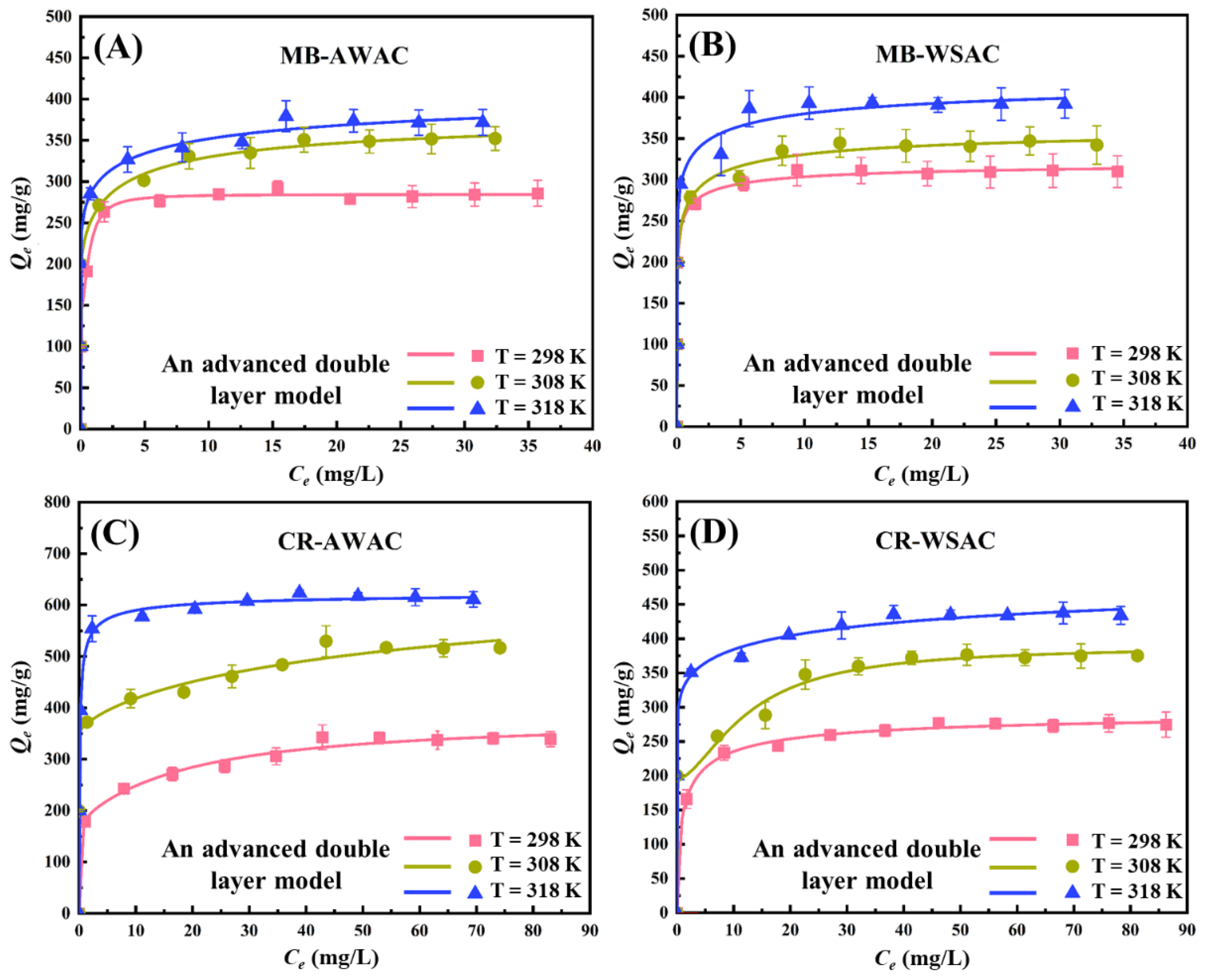
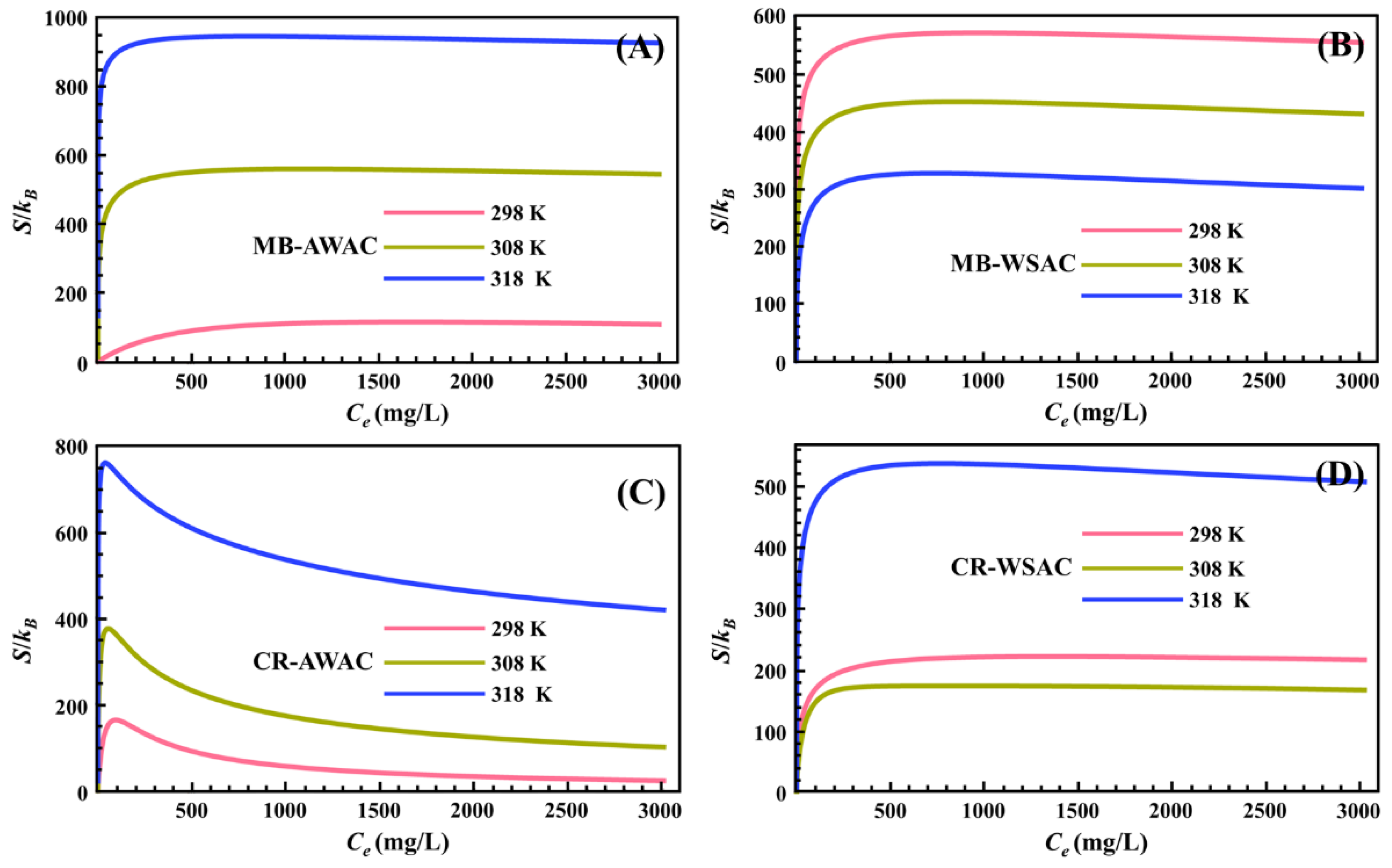
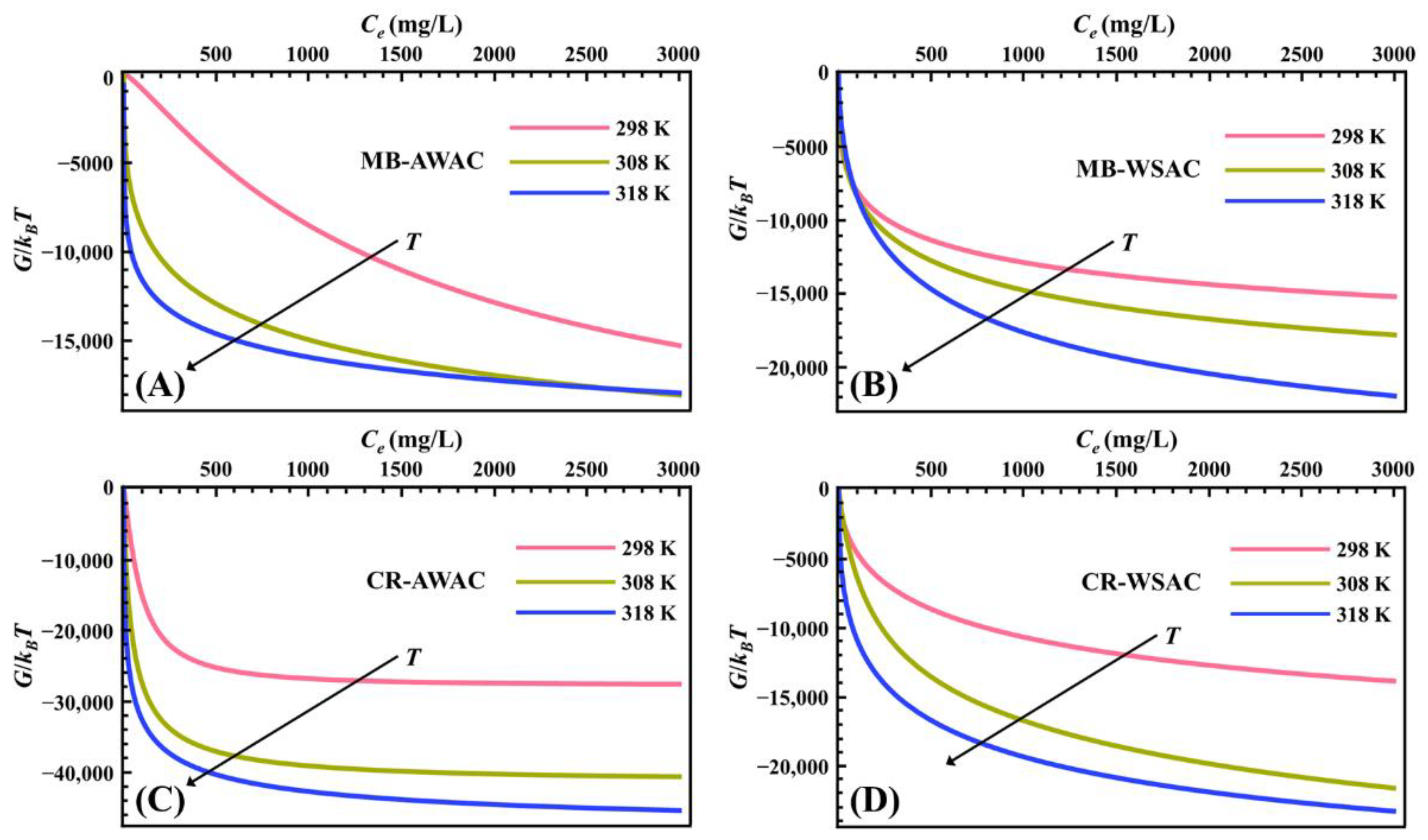
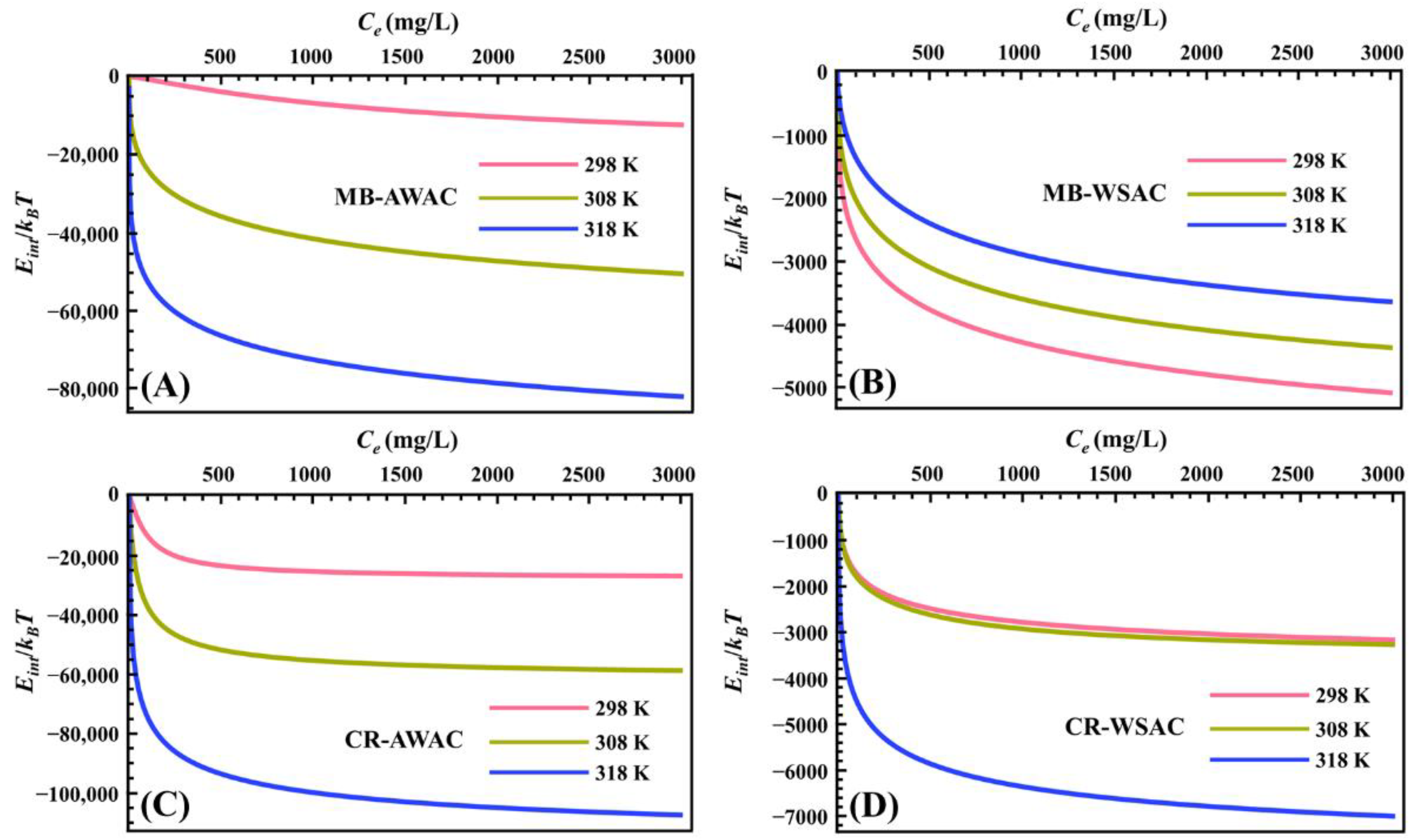
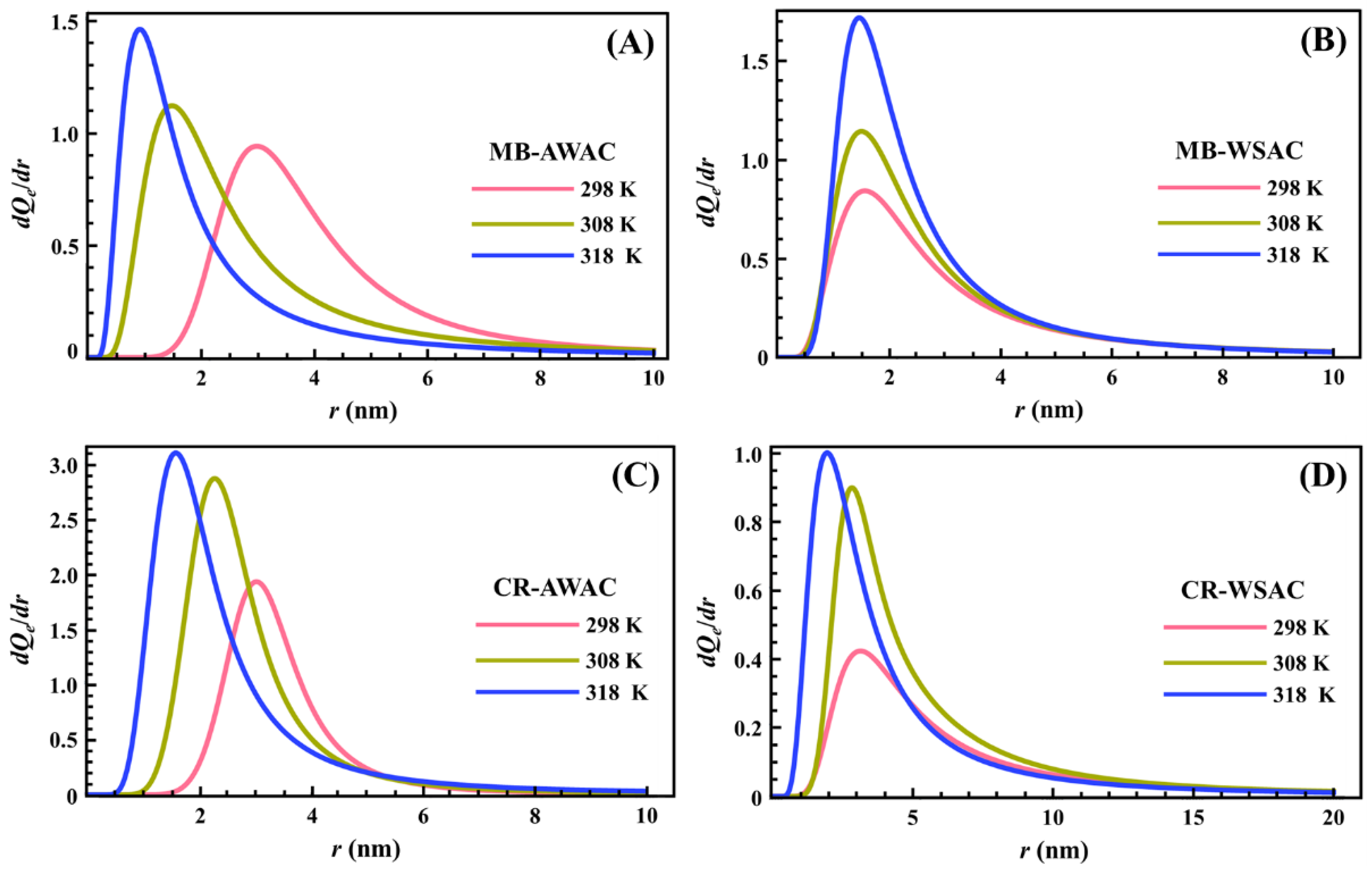
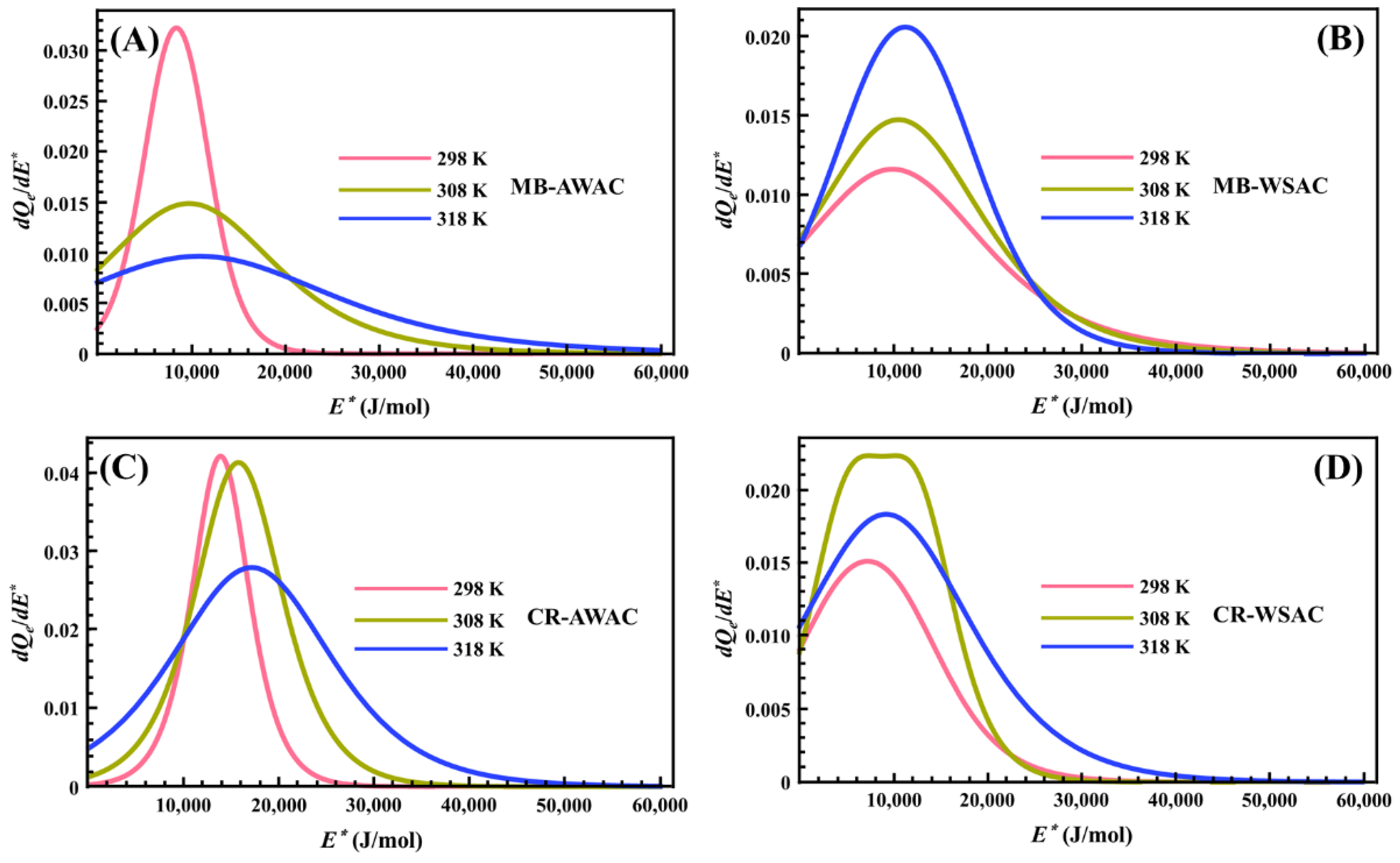
Publisher’s Note: MDPI stays neutral with regard to jurisdictional claims in published maps and institutional affiliations. |
© 2022 by the authors. Licensee MDPI, Basel, Switzerland. This article is an open access article distributed under the terms and conditions of the Creative Commons Attribution (CC BY) license (https://creativecommons.org/licenses/by/4.0/).
Share and Cite
Zhang, L.; Yang, L.; Chen, J.; Yin, W.; Zhang, Y.; Zhou, X.; Gao, F.; Zhao, J. Adsorption of Congo Red and Methylene Blue onto Nanopore-Structured Ashitaba Waste and Walnut Shell-Based Activated Carbons: Statistical Thermodynamic Investigations, Pore Size and Site Energy Distribution Studies. Nanomaterials 2022, 12, 3831. https://doi.org/10.3390/nano12213831
Zhang L, Yang L, Chen J, Yin W, Zhang Y, Zhou X, Gao F, Zhao J. Adsorption of Congo Red and Methylene Blue onto Nanopore-Structured Ashitaba Waste and Walnut Shell-Based Activated Carbons: Statistical Thermodynamic Investigations, Pore Size and Site Energy Distribution Studies. Nanomaterials. 2022; 12(21):3831. https://doi.org/10.3390/nano12213831
Chicago/Turabian StyleZhang, Lei, Libin Yang, Jiabin Chen, Wenjun Yin, Yalei Zhang, Xuefei Zhou, Feng Gao, and Jiang Zhao. 2022. "Adsorption of Congo Red and Methylene Blue onto Nanopore-Structured Ashitaba Waste and Walnut Shell-Based Activated Carbons: Statistical Thermodynamic Investigations, Pore Size and Site Energy Distribution Studies" Nanomaterials 12, no. 21: 3831. https://doi.org/10.3390/nano12213831
APA StyleZhang, L., Yang, L., Chen, J., Yin, W., Zhang, Y., Zhou, X., Gao, F., & Zhao, J. (2022). Adsorption of Congo Red and Methylene Blue onto Nanopore-Structured Ashitaba Waste and Walnut Shell-Based Activated Carbons: Statistical Thermodynamic Investigations, Pore Size and Site Energy Distribution Studies. Nanomaterials, 12(21), 3831. https://doi.org/10.3390/nano12213831






